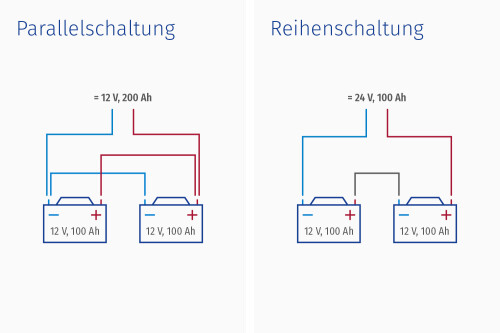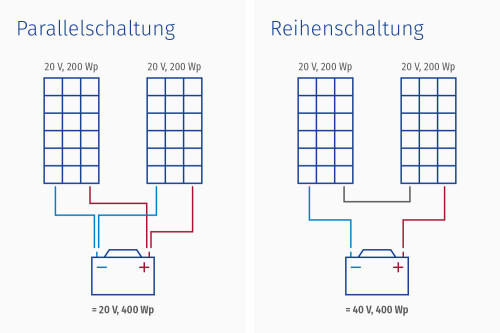
Parallel and series connection of batteries
The possibilities for increasing voltage and/or power are almost infinite, because basically any number of batteries can be connected together. There are two methods for this: parallel and series connection. In addition, it is possible to combine both types of connection by means of the so-called series-parallel connection. This is often used in practice when you want to increase both the voltage and the capacity - for example in modern lithium batteries for traction or auxiliary batteries.
The techniques of parallel connection and series connection offer a way of circumventing the limitations of a single battery and creating customised energy solutions for a wide variety of requirements. In purely practical terms, this works as follows:
In parallel connection, batteries are connected so that their positive terminals are connected to each other and their negative terminals are connected to each other. This increases the total capacity of the batteries while the voltage remains unchanged. A good example of parallel connection is connecting batteries together in a motorhome or on a yacht to provide a longer power supply for various devices. Several batteries are also often connected in parallel in special vehicles such as sewer inspection vehicles.
In series connection, the positive poles of one battery are connected to the negative poles of the next battery. This method increases the total voltage of the batteries while the capacity remains the same. The starter batteries in trucks or buses are often operated in series connection to generate a higher voltage for the on-board network.

Parallel and series connection of batteries
With a capacity of 210 Ah, our Energy Unit with XBU consists of a total of 504 cells of the 18650 type - 7 modules with 72 individual cells each, to be precise. The individual components with 2.85 Ah and 3.7 V each are connected in parallel in a module to a capacity of 210 Ah. However, the voltage remains the same in the parallel connection.
To increase this to 24 V (effectively 26 V), 7 of these modules are connected in series. This results in the capacity of (72 x 2.85) 210 Ah and the voltage of (7 x 3.7) 26 V for our standard model.
The XBU is also available in two other versions with 420 Ah and 630 Ah. Here, two (for the XBU 420) or three (XBU 630) of the 7-series modules are connected in parallel to achieve the larger capacity. In all XBU variants, a cell type is used that has been successfully produced in large-scale production for years and is also used in electric vehicles (including the Tesla Model S).
When interconnecting - whether in series or in parallel - only use batteries that:
are of the same battery type.
have the same capacity.
are of the same age.
are at the same state of charge.
In a new installation, one usually makes sure to use identical batteries in terms of type, capacity and age. However, it is equally important that they have the same state of charge. For when batteries with different states of charge are connected together, they do not equalise again during subsequent charging and discharging in the network and will drift further and further apart in the course of their - short - lifetime.
Even if part of the battery bank fails at some point, it does not make sense to replace only the defective battery. This is because if a new battery is placed with others that have already undergone several charging and discharging cycles, this will always have a negative impact on performance and service life.
The older battery usually has less usable capacity due to increased internal resistance, can deliver less current and absorbs charge more slowly. Sooner or later, this will lead to one of the two batteries ageing faster than average and the battery bank failing again in a relatively short time.
It is therefore highly recommended that in battery banks connected in series or parallel, if one battery fails, ideally all batteries should be replaced with batteries of the same age.
In summary, series or parallel connection of batteries is a common means of circumventing limitations in terms of size, capacity and voltage. In order to take advantage of as many benefits as possible and minimise disadvantages, certain prerequisites must be observed. If you take these into account, you will get a customised, reliable power supply for your needs.
Interconnection to increase voltage or power is not only limited to batteries. The interconnection of several solar modules is also common practice, especially in larger installations. Here, too, there are different forms of application, but the rules for parallel and series connection remain the same.
In mobile applications (mobile homes, etc.), the solar modules are often connected in parallel. In stationary building applications (roof installations etc.), series connections or combinations of series and parallel connections are usually common in order to achieve higher input voltages for the inverters used.

Parallel and series connection of solar modules
By connecting two solar modules in parallel, the total power is doubled, the nominal voltage remains the same, the total current doubles. In the diagram shown above, 2 solar modules, each with 20 V and 200 Wp (Watt peak), are connected in parallel. A total of 400 Wp (= 2 x 200 Wp) is then available at 20 V, with a current of 20 A flowing.
Again, a series connection of two modules delivers twice the rated voltage of the individual modules, the total current is equal to the current of one module. The total power is twice the power of one module. In the example, 40 V (2 x 20 V) at 10 A and 400 Wp (2 x 200 Watt peak) are available. Please note that the permissible input voltage of the solar charge controller is not exceeded.
In principle, the statements described above can be applied to other devices such as chargers, DC-DC converters and power supplies. However, it should be noted that these are often devices that electronically monitor and regulate their output power. The reference potential of the output voltage must also be taken into account before interconnecting unknown current sources. Therefore, before interconnecting several devices regulated in this way, one should consult the manufacturer or refer to the user manual to ensure the reliability of this measure.
Any questions? Please contact us: